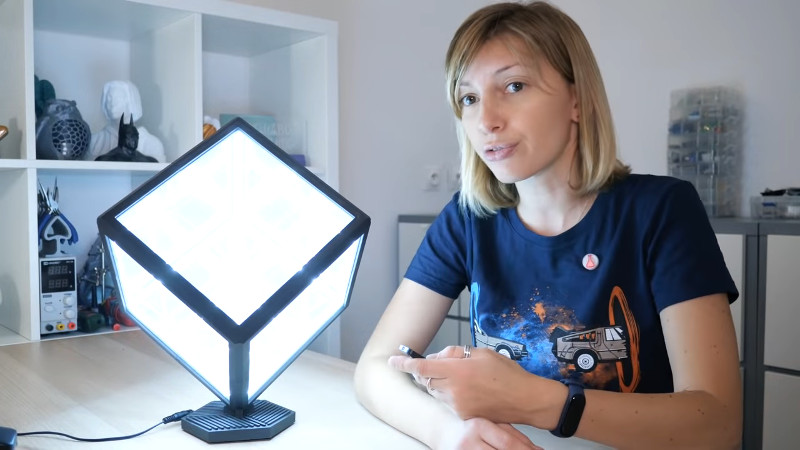Typically when we hear the words “LED” and “Cube”, we think of small blinking devices on protoboard designed to flex one’s programming and soldering skills. However, while [Heliox]’s Cube Infini could be described as “a cube of LEDs”, it’s rather a different beast (video in French, subtitles available).
The cube starts with a 3D printed frame, designed in Fusion 360. The devil really is in the details — [Heliox] puts in nice touches, such as the artistic cube relief on the base, and the smart integrated cable management in the edges. The faces of the cube are plexiglass sheets, covered with a one-way reflective film that is applied in a similar manner to automotive window tint. For lighting, a high-density LED strip is fitted to the inside edges, chosen for maximum visual effect. It’s controlled by an IR remote and a cheap control module from Amazon.
While the build contains no particularly advanced tools, materials, or techniques, the final result is absolutely stunning. It’s a piece we’d love to have as a lamp in a stylish loungeroom or study. [Heliox] does a great job of explaining how the cube is designed and fits together, and it’s a testament to just what can be achieved with a little ingenuity and hard work.
Once you’re done here, check out this ping-pong based build.
[Thanks to Emile for the tip!]















It’s not an IR remote, it’s RF.
Oh, wacky… the receiver clearly says it’s RF, but the remote control really looks like it has a photodiode on it.
It certain does but the documentation that she provides on the youtube page links to a 433 Mhz remote on banggood (not amazon)
They probably just use the same case no matter which board ends up in it.
Generic remote housing.
Complete with a dummy transparent blob where the IR LED would have been?
Maybe the remote is simultaneously both IR and 433MHz?
It’s an led on top that just lets you know the remote is working according to the manual for some of them. Just an indicator.
So awesome!
If you look closely in the main article pic, there’s also a cool spade-shaped tool holder on top of the lab power supply on the shelf.
Oh! For pliers! Never seen anything like that.
Thanks :)))
You can find it here: https://www.thingiverse.com/thing:2722893 :)
All I can get is auto generated french subtitles. Auto translate won’t turn on. :P
click auto translate > select English.
ah, I see the issue. go to the video on youtube, does not seem to work with the embedded video above.
Really, there is enough visual information, I don’t think the subtitles could add much.
Metal finger ornaments and electricity do not mix well. Maybe that is a lesson you have to learn the hard way, I did.
Axelle [Heliox] is a very creative maker. She deserves being in Hackaday.
Have a look at her other projects.
The cool effect of infinity mirrors and lights always gets me,
Making it into a cube is cool to the power of 3. Nice build.
Would look good as an ornament inside the TARDIS
Cubes? …Great!!! … Now Tetrahedrons… Should be very cool too.
Once again, Sean Hogins may have done it first?
https://www.youtube.com/watch?v=DCqymgH1_Ts
The mirrors on the center cube don’t actually do anything, especially since the cube itself is solid. It might look better if that was printed as edges only. Even then, there may be nothing for those mirrors to actually reflect.
This looks awesome.
One thing I don’t understand (probably because I don’t understand a single french word), why is it so difficult to parallel-connect all the led strips?
I think the way she did it is a little bit of overkill. Those LED strips will work fine over a 5 m length, so it should be no problem at all to just connect all three strips at each corner, and just wire it to the base from the base corner. This splits the current evenly, three ways, so in effect you’re powering only four strips (about 1 m) through each.